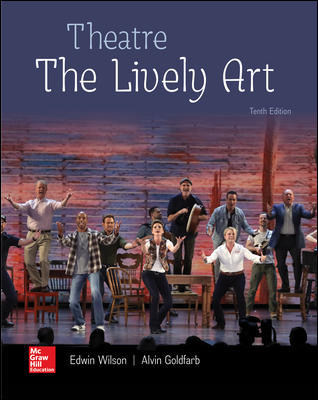Description
Test Bank For Theatre The Lively Art 10Th Edition By Edwin Wilson
Table of Contents
Part 1. Theatre in Today’s World
Chapter 1. Theatre is Everywhere
Chapter 2. The Audience
Part 2. Creating Theatre: The Playwright
Chapter 3. Creating the Dramatic Script
Chapter 4. Theatrical Genres
Part 3. Creating Theatre: The Production
Chapter 5. Acting for the Stage
Chapter 6. The Director and the Producer
Chapter 7. Theatre Spaces
Chapter 8. Scenery
Chapter 9. Stage Costumes
Chapter 10. Lighting and Sound
Part 4. Global Theatres: Past and Present
Chapter 11. Early Theatre: Greek, Roman, and Medieval
Chapter 12. Early Theatre: Asian
Chapter 13. Renaissance Theatres
Chapter 14. Theatre from the Restoration through Romanticism
Chapter 15. The Modern Theatre Emerges
Chapter 16. Today’s Diverse Global Theatre
Theatre: The Lively Art, 10e (Wilson)
Chapter 3 Creating the Dramatic Script
1) A full account of an event or series of events, usually in chronological order, is called a
A) plot.
B) story.
C) drama.
D) climax.
2) A main difference between episodic and climactic forms of structure is that episodic construction emphasizes
A) a clear, linear plot.
B) a few solid, extended scenes.
C) constriction and compression on all fronts.
D) a broader view with a cumulative effect.
3) The selection and arrangement of scenes that actually happen onstage is called the
A) plot.
B) story.
C) crisis.
D) climax.
4) Which of the following is NOT an essential aspect of dramatic structure?
A) plot
B) reasonable balance
C) conflict
D) mutually agreeable forces
5) The final and most significant crisis is referred to as the
A) complication.
B) obstacle.
C) climax.
D) through line.
6) Shakespeare’s plays typically included subplots, which are
A) major parallel plots about the play’s antagonist.
B) secondary plots that reinforce or runs parallel to the major plot.
C) secondary plots written in the tradition of the well-made play.
D) juxtapositions of comedic and serious scenes.
7) The imparting of details about the past that are essential but not covered by the action onstage is known as
A) exposition.
B) ritual.
C) juxtaposition.
D) narration.
8) The dramatic structure that piles up people, places, and events is called
A) absurdist.
B) heroic.
C) climactic.
D) episodic.
9) An open-ended, serial structure that is often associated with female playwrights is ________ structure.
A) pattern
B) cyclical
C) ritual
D) experimental
10) Which of the following is NOT a convention of common climactic dramatic structure?
A) limited space
B) limited time
C) limited conflict
D) strongly opposed forces
11) A hallmark of commedia dell’arte is its
A) strict structure.
B) three-dimensional characters.
C) chorus.
D) improvisation.
12) Characters that embody the quintessential characteristics of a group are known as ________ characters.
A) representative
B) stock
C) dominant trait
D) minor
13) The central conflict and movement through a drama is referred to as the ________ of the play.
A) obstacle
B) exposition
C) climax
D) action
14) Experimental theatre groups in the second half of the twentieth century developed dramatic forms based on ritual, which is
A) an improvised dialogue based on a single suggestion.
B) a reenactment of actions that have acquired special meaning.
C) a series of episodes that are strung together in a single presentation.
D) a set of repeated movements or actions, much like dance choreography.
15) Which type of dramatic structure requires extensive exposition?
A) climactic structure
B) episodic structure
C) cyclical structure
D) serial structure
16) The structure of William Shakespeare’s plays are typically
A) climactic.
B) episodic.
C) cyclical.
D) serial.
17) The dramatic structure which does not build to a single climax and in which actions are repeated is
A) climactic structure.
B) episodic structure.
C) cyclical structure.
D) serial structure.
18) Which type of dramatic structure is exemplified by a musical revue or an evening of one-act plays?
A) climactic structure
B) episodic structure
C) cyclical structure
D) serial structure
19) Which type of dramatic structure features large numbers of locales?
A) climactic structure
B) episodic structure
C) cyclical structure
D) serial structure
20) Which type of dramatic structure sometimes features little to no connection between its parts?
A) climactic structure
B) episodic structure
C) cyclical structure
D) serial structure
21) In which type of dramatic structure do events have a strong cause-and-effect relationship with the action of the play?
A) climactic structure
B) episodic structure
C) cyclical structure
D) serial structure
22) Which type of dramatic structure has been embraced by feminist playwrights as being open-ended and fragmentary?
A) climactic structure
B) episodic structure
C) cyclical structure
D) serial structure
23) Which type of dramatic structure may have a single parallel subplot or even multiple subplots?
A) climactic structure
B) episodic structure
C) cyclical structure
D) serial structure
24) Which type of dramatic structure uses the technique of juxtaposition and contrast to connect scenes?
A) climactic structure
B) episodic structure
C) cyclical structure
D) serial structure
25) In which type of dramatic structure is the construction of the plot is very tight?
A) climactic structure
B) episodic structure
C) cyclical structure
D) serial structure
26) In which type of dramatic structure does the plot or action of the play begin very late in the story?
A) climactic structure
B) episodic structure
C) cyclical structure
D) serial structure




Be the first to review “Test Bank For Theatre The Lively Art 10Th Edition By Edwin Wilson”